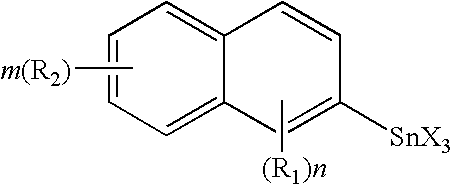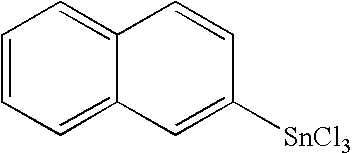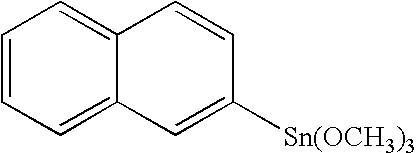Novel organo-metal compounds
a technology of organometallic compounds and compounds, applied in the field of organometallic compounds, can solve the problems that siloxane based organic hybrid materials of the above kind do not always perform satisfactorily when used as polymeric host or matrix materials in optoelectronic applications
- Summary
- Abstract
- Description
- Claims
- Application Information
AI Technical Summary
Benefits of technology
Problems solved by technology
Method used
Image
Examples
example i
MONOMER EXAMPLE I
[0084] Mg (4.89 g) was placed in a round bottom flask. Two small spoons of granulated I2 granules were added to the flask. The reaction mixture was stirred at room temperature for 30 minutes. Bromonaphthalene (23.2 ml) was added by a syringe through a needle into the flask. Also 2 drops of 1,2-dibromoethane were added. The reaction mixture was stirred at room temperature for 45 min. 87 g of SnCl4 was added using a syringe and a needle into the reaction flask. 30 ml of Et2O was added to the flask in small portions. Immediately after the first portion, the reaction mixture became warmer. The temperature rose until the reaction mixture was slightly refluxing. The reaction mixture was allowed to reflux at 75° C. for 12 hours. 160 ml of toluene was added to “extract” the material from the round bottom flask. The solution was transferred with syringe via a needle to another round bottom flask. Unreacted SnCl4 and toluene were removed by distillation and a material product...
polymer example i
[0086] 7.84 g of naphthalene trichlorotin was weighed into a round bottom flask and dissolved in 36.06 g of dichloromethane (DCM). Another solution containing DCM:H20 (1:8) suspension (5 ml:31 ml) was placed to a round bottom flask in an ice-bath. The naphthalene trichlorotin:DCM solution was added slowly to DCM:H20 solution by using dropping funnel. After addition, reaction mixture was stirred at room temperature for 145 min. Reaction mixture was placed to a separation funnel. 406 g of DCM and 50 ml of deionized water were added to the separation funnel. DCM and H2O layers were let to separate. After separation of the layers the DCM layer was filtrated using a filter paper. After filtration the solvent (DCM) was removed using a rotavapor (12 mbar, 40° C. bath temp, 30 min) followed by a high vacuum step (3 mbar, at room temperature). 3.67 g of clear material was obtained. The synthesized polymer was dissolved in 3.67 g of propylene glycol monomethyl ether acetate (PGMEA) and mixed ...
PUM
| Property | Measurement | Unit |
|---|---|---|
| refractive index | aaaaa | aaaaa |
| reaction time | aaaaa | aaaaa |
| temperature | aaaaa | aaaaa |
Abstract
Description
Claims
Application Information
 Login to View More
Login to View More - R&D
- Intellectual Property
- Life Sciences
- Materials
- Tech Scout
- Unparalleled Data Quality
- Higher Quality Content
- 60% Fewer Hallucinations
Browse by: Latest US Patents, China's latest patents, Technical Efficacy Thesaurus, Application Domain, Technology Topic, Popular Technical Reports.
© 2025 PatSnap. All rights reserved.Legal|Privacy policy|Modern Slavery Act Transparency Statement|Sitemap|About US| Contact US: help@patsnap.com



